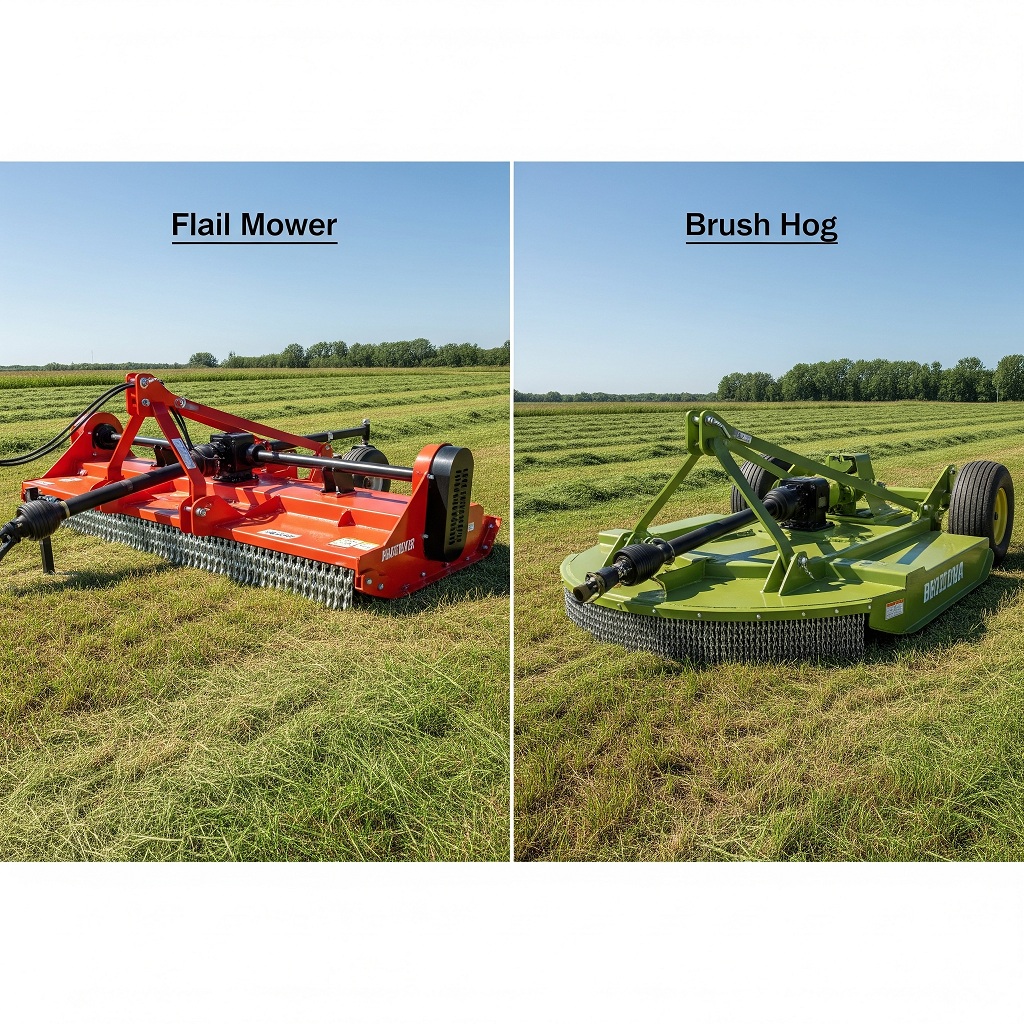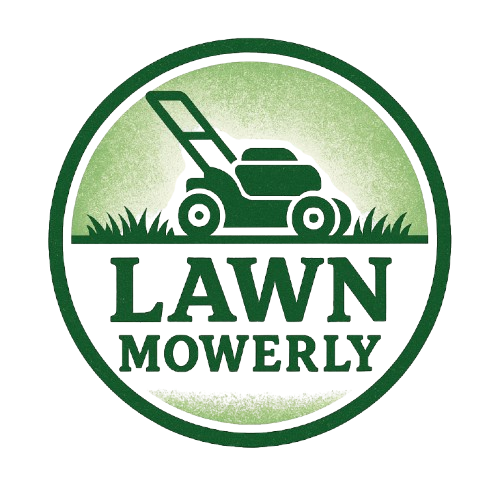
Choosing between a flail mower and a brush hog (rotary cutter) is a major decision for property owners looking to maintain large fields, pastures, roadside verges, or tackle unruly brush. While both are tractor-powered attachments meant for heavy-duty cutting, they differ significantly in design, function, and outcomes. This detailed guide will unpack their core differences, pros and cons, ideal use-cases, and the price landscape—so you can confidently select the right tool for your land.
1. How Each Mower Works
Flail Mower
A flail mower features a horizontal rotor (drum) equipped with dozens of small, free-swinging blades (called “flails”, “hammers”, or “knives”). As the drum spins at high speed, the flails use centrifugal force to cut and shred grass, weeds, vines, and light brush. The cuttings circulate longer beneath the mower, resulting in a finely mulched, evenly distributed residue.
- Blade Types: Y-blades (for rougher material and mulching), hammer/flail blades (for cleaner, finer cuts or finish). Some models have variable angles for bank cutting or hedging.
- Finish: Leaves a manicured, uniform, and healthy cut—ideal for aesthetics and land health.
Brush Hog (Rotary Cutter)
A brush hog relies on 1-2 heavy, thick blades mounted to a central spindle. These blades spin horizontally with tremendous force—shearing through dense brush, saplings, and thick grass with brute power rather than finesse.
- Blade Nature: Dull, heavy to withstand repeated impacts with rocks, stumps, and debris.
- Finish: Rough, uneven cut; debris is often flung outward (less controlled).
2. Head-to-Head Performance Comparison
| Criteria | Flail Mower | Brush Hog (Rotary Cutter) |
|---|---|---|
| Cut Quality | Very clean, even, fine mulch, superior for grasslands and aesthetics | Coarse, uneven, can leave ragged edges |
| Capacity (Material) | Grass, weeds, vines, light-to-medium brush, overgrowth | Tall weeds, dense brush, saplings, small trees |
| Terrain Adaptability | Handles uneven ground, ditches, slopes well | Best for open, flat fields |
| Speed/Efficiency | Slower coverage, especially thick growth | Very fast, covers more acres/hour |
| Safety | Mulched debris stays under deck, reduced projectile risk | Flinging of rocks, sticks—greater risk |
| Maintenance | Many flails to replace/sharpen, more moving parts | 1-2 blades: simple, robust |
| Durability | Resistant to rocks; single flail can be replaced | Blades/gearbox can be damaged badly by impact |
| Power Needs | Requires more horsepower per foot of width | Lower hp needed for equivalent width |
| Storage | Compact, doesn’t protrude much | Bulky, sticks out farther |
| Cost (2025) | $2,500–$10,000 new; more expensive | $500–$5,000 new; cheaper on average |
3. Detailed Pros & Cons
Flail Mower – Pros
- Superior Cut & Mulching: Leaves a finer, cleaner, more level finish—mulches clippings to enrich soil.
- Safer in Debris: Less chance of rocks/sticks being ejected, safer around people, near roads or sensitive areas.
- Versatile: Capable of tackling grass, light brush, vines, and even some thicker material with the right blades.
- Terrain Handling: Maneuvers well on slopes, banks, ditches—can sometimes angle for vertical trimming (hedges).
- Removable/Replaceable Flails: Single damaged flails mean cheaper, quicker repair.
Flail Mower – Cons
- Initial & Maintenance Cost: Generally much more expensive to buy and maintain; many blades to replace.
- Slower Operation: Doesn’t clear large swathes as quickly as a rotary cutter.
- Power Demand: More PTO horsepower needed for the same working width.
- Complex Maintenance: More moving parts, more frequent servicing needed.
Brush Hog – Pros
- Efficient Clearing: Excellent for fast, rough clearing of big fields, meadows, overgrown land, and light woody growth.
- Handles Heavy Material: Chops saplings, thick weeds, small trees with brute force.
- Lower Upfront/Maintenance Costs: Simpler design, easier to sharpen/replace blades; less expensive to buy.
- Faster Coverage: Great for mowing many acres in a short time; maximizes productivity.
- Durability: Robust; but needs to be checked for possible major damage from big impacts.
Brush Hog – Cons
- Rough Finish: Leaves uneven, stringy cut—poor for lawns or aesthetic pastures.
- Safety Hazards: Throws rocks/debris; caution needed near traffic, livestock, or people.
- Limited Terrain Flexibility: Less suitable for banks, ditches, or rough, rocky terrain—may risk blade/gearbox damage.
- Less Effective for Mulch: Clippings can pile into clumps instead of mulching evenly.
4. Ideal Use Cases & Scenarios
Choose a Flail Mower If:
- You need the cleanest, most finished cut possible (horse pastures, public parks, estate lawns, municipal roadside maintenance).
- Safety is a major concern (near homes, patios, roads, livestock, or children at play).
- The property includes slopes, uneven surfaces, ditches, or lots of obstacles.
- You want to return finely mulched material to soil for improved health.
- Occasional light woody brush and dense vines need control.
Choose a Brush Hog If:
- Your land has large, open, or overgrown meadows that need fast, coarse clearing.
- You need to clear light forest underbrush, thick grass, tall weeds, and even saplings regularly.
- Initial land reclamation, pasture restoration, or preparation for new construction.
- Lower purchase and maintenance costs are higher priorities than finish quality.
- Fewer obstacles/rocks and minimal bystander risk.
5. Price & Operating Cost Comparison (2025)
- Flail Mower:
- $2,500–$10,000 new for compact tractor-compatible models; replacement flails $2–$10 each, with up to 50–100 per mower for wide units.
- Higher maintenance: bearings, flails, belts.
- Brush Hog:
- $500–$5,000 new; usually cheaper per working foot.
- Blade sharpening/replacement is less frequent and usually less costly overall.
Note: Cheap, imported, or off-brand models can be found for less, but may require higher maintenance or repairs.
6. Common User Experiences
- Rocky, Stumpy Fields: Flail mowers are less likely to catastrophically fail on a rock strike—just change a flail. Brush hogs can experience severe damage to blades, spindles, or gearboxes.
- Fine Clippings: Flail mowers mulch, distribute, and prevent thatch build-up, especially good for wildlife plots or soil restoration.
- Dense Woody Growth: Brush hogs win on saplings, thick brush, or when cutting is prioritized over finish.
- Ease of Use: Brush hogs are lighter on maintenance, easier for beginners or those with less time/mechanical skill.
7. Environmental and Agronomic Benefits
- Flail mowers are superior for sustainable land management: they reduce soil erosion, improve organic matter return, and are less likely to cause plant scalping or bare spots.
- Rotary cutters (brush hogs) help quickly clear invasive or problematic woody plants, opening land to new use or rotational grazing.
8. Final Decision Factors
When buying, consider:
- Type and density of vegetation
- Terrain (flat, rough, rocky, sloped)
- Required finish quality
- Tractor horsepower/size
- Proximity to people, roads, or livestock
- Budget (upfront and annual maintenance)
Pro Tip: Many land managers own both—a brush hog for rough clearing, and a flail mower for maintenance and finish passes as land transitions to pasture or turf.
9. FAQs
- Can a flail mower replace both a rough and finish mower?
Yes, quality flail mowers can deliver both rough and “lawn-like” finish cuts, depending on blades selected. - Is a brush hog or flail mower easier to store?
Flail mowers are typically more compact and easier to maneuver, while brush hogs are bulkier. - What about maintenance skill?
Brush hogs are simpler; flail mowers with dozens of blades are more complex and benefit from regular user inspection.
Summary:
A brush hog (rotary cutter) dominates for aggressive land clearing, speed, and tackling dense, tall material quickly on open ground. The flail mower excels in finish, mulching, terrain versatility, and safety—at a higher price point with more intensive maintenance. Your debate isn’t about which mower is “best”—it’s about which best matches your specific land, tasks, safety needs, and long-term goals.

I’m David man behind Lawn Mowerly; I’ve been dealing with lawnmowers and Tractors with my father since I was a kid. I know every make and model and what each one is capable of and love helping people find the perfect equipment for their needs.
